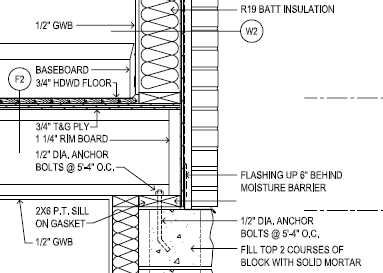Floors
The floors of a building are combined of various assemblies of materials. For houses the most common floor structure is a wood joist system with wood, tile or carpet and a ceiling finish below comprised of Gypsum Wallboard. The size of the floor joists can be determined using the Building Code or using Manufacturer's specifications.
Regardless of the specific materials being used, there are some
specific functions that a floor at wall detaill needs to provide
such as structural support, waterproofing, thermal protection
and durability. Consider the detail below that shows a typical
floor at wall detail for a wood framed house.
.

.
Section Through Foundation Wall at Floor
The drawing above shows a section through a first
floor at wall. From top to botoom, the floor system is comprised of 3/4"
hardwood, 3/4" Tongue and Groove (T&G) plywood, 11 1/2" I Joists, and 1/2"
Gypsum Wall Board (GWB).
The foundation wall
is a 10 inch block wall. If the siding were wood or stucco or some other material that did not
require the structural support of brick veneer, the block width could be 8
inches.
When you research
these kinds of details, you will find many iterations (and drawing styles) that
show floor at wall details for wood framed houses in different ways. The
important aspects to remember are the various qualities that all floor at wall
details will have in common. In the drawing above, the floor system is held to
the foundation wall with a sill plate on a gasket that is anchor bolted to the
wall. If concrete block is used, the top course of block is filled with mortar
or non shrink grout to receive the anchor bolts. If poured concrete is used, the
bolts are placed in the wet concrete.
The floor joists are then fastened to the
sill plate providing a solid connection between the floor system and the wall.
The structural connection between the wall and the floor is an inherent aspect
of any detail that provides information on how to assemble a floor to wall
detail.
.